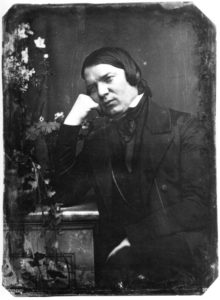This month, the Houston Symphony presents a two-week Schumann Festival featuring the great Romantic composer’s symphonies, concertos, chamber music, songs, and more. In this post, discover Schumann’s enchanting Piano Quartet, a work that marries Romantic lyricism with baroque counterpoint.
Schumann’s Piano Quartet dates from the autumn of 1842, known as “the year of chamber music.” In this year, he composed not only this work, but also three string quartets, a piano quintet, and a set of Phantasiestücke (“fantasy pieces”) for piano trio. Despite this remarkable productivity, the year was nevertheless a difficult one for Schumann emotionally as he struggled with bouts of depression. During these dark periods, Schumann frequently found solace in studying counterpoint—the art of combining multiple melodies simultaneously—together with his wife, Clara. These studies are certainly reflected in the Piano Quartet, which features many contrapuntal passages, including canons and fugues. Despite Schumann’s troubled mental state, the piece is one of his sunniest, most delightful works.
It begins with a brief, but slow introduction featuring a chorale-like melody:
This sustained theme then becomes the principal idea of the faster, main body of the movement. This main idea is elaborated and developed (often contrapuntally) until the slow introduction returns, signaling further developments that pass through darker, more intense tonalities. After the triumphant return of the main idea in the home key of E-flat major, the tempo slows once more just before the movement’s wistful coda.

The main theme of the following scherzo clearly invokes Mendelssohn’s famous “fairy music” style. The piano and strings also frequently echo each other canonically, recalling the scherzo from Schubert’s Piano Trio in E-flat major, one of Schumann’s favorite pieces. The movement has an ABACA form—the “fairy music” alternates with contrasting episodes (although it sometimes intrudes on them, as if the fairies’ dance is continuing in the background of these other scenes).
For many, the third movement is the heart of the work. After a few bars of introduction, the cello begins a singing melody that reminds one of Schumann’s gifts as a composer of vocal music. A series of variations on this expressive theme ensues, beginning with a quasi-canonic duet for the violin and cello. The variations are interrupted when the music slips into the distant key of G-flat major for a contrasting section featuring chorale-like textures. The variations resume as the viola plays the main theme. In an unconventional twist characteristic of the composer, Schumann asks the cello to tune down its lowest string from a C to a B-flat. At the end of the movement, the cello plays a long pedal note on this low B-flat as the other instruments subtly introduce what will become the main idea of the finale.
Based on the final thought of the previous movement, the finale soon launches into a fast fugue—a type of music in which a main idea is passed from one part to another amid a complex, contrapuntal texture. Though finales are most often easy-going affairs, there was also a long tradition of learned, fugal finales going back to the 18th century (Mozart’s “Jupiter” Symphony provides a famous example). Schumann is clearly participating in that tradition here. Alternating with more lyrical, contrasting episodes, the main idea is developed with a dazzling array of contrapuntal techniques, culminating in a grand coda in which it overlaps with itself to kaleidoscopic effect.—Calvin Dotsey
Don’t miss Schumann’s Piano Quartet at the Houston Symphony’s Schumann Festival! Learn more and get tickets.



